
Exhibiting
Page
of
Randy Asplund
This page will eventually be expanded
with new images
© Randy
Asplund
At The University of Michigan, Slusser Gallery, January, 2008
|
In the course of his career Randy has exhibited in galleries, museums,
planetariums, SF convention art shows, medieval reenactment events
castles in Europe and bookfestivals. Sometimes the event is a display
of finished works, and sometimes it means bringing out the tools and
materials of his craft to display in cases. Here are a few pictures
from some of the exhibits Randy has done.... Making and Breaking Medieval Manuscripts
On view at the Krannert Art Museum at the University of Illinois through February 11, 2017 I was asked by the museum if they could borrow some of my tools and materials for this exhibition. The next four images are shots of the display case with contributions. All four photos courtesy of the curator, Dr. Maureen Warren. This is the overview of the display case In addition to the colors in shells we have clothlets, which were a way to store dye based color. You simply cut off a piece, laid it in the color well with some binder solution and allowed the color tostain the fluid. The colors you see here were made from buckthorn, Swedish bilberries, poppies, cornflowers, and greens from purple iris and violets. At top you see my ink pot and my waxed tablet for taking notes and composing designs and text. These are writing tools. Quills for red and black inks, a pen knife, a leather case for carying everything, and an attached ink pot. At the upper left are an agate burnisher and a horse tooth burnisher laid upon a pad for holding the gold leaf. **** Silver Bells In The City 2016: The Library of the State of Michigan I was engaged to do a one night presentation in the Rotunda between the entrances to the State Library and Museum. I brought a lot of things. This was going on while my other tools and materials were at the Krannert Art Museum, seen above. I brought some art, my scribe desk, a trestle table , several examples of books I have made, a scale model of a parchment being made on a rack, and I filled two display cases with more tools, color & ink samples, and the materials they are made from. This case has a copy of my more contemporary binding of Anderson's The Little Mermaid, and my Jeanne d'Arc miniature book. On the left is an extensive color chart depicting swatches of most of the medieval pigments painted onto parchment squares. This is a front view of the case in the following picture- Here we have a whole lot f pigments, many of which are very exotic and rare. The verdigris in the upper left corner is in a box made from a solid chunk of oak (from the centennial oak across the street after lightning got it). The object to its right is a pedestal type cresset lamp (used for lighting the home, but also for collecting soot for lamp black pigment). There's a brick from a 14th c. building which I hollowed out to use as a fluid absorbing mass when making the yellow lake pigment called "weld." In the center is rocella tinctoria, which is also known as orchil. It makes the purple which was also used for dying the purple pages of the most lavish medieval books. . We also have Dragon's Blood, Brazilwood lake, Kermes, Orpiment & Realgar, Lapis Lazuli from Afghanistan, Red White and Yellow Lead colors, Iris Green, Sap Green & Buckthorn Yellow, Malachite, Azurite, and others. *** Randy & Ann at the 2016 Kerrytown Bookfest with our new medieval trestle table. I did demos of medieval book arts. Here we have a whole lot f pigments, many of which are very exotic and rare. The verdigris in the upper left corner is in a box made from a solid chunk of oak (from the centenial oak across the street after lightning got it). The object to its right is a pedestal type cresset lamp (used for lighting the home, but also for collecting soot for lamp black pigment). There's a brick from a 14th c. building which I hollowed out to use as a fluid absorbing mass when making the yellow lake pigment called "weld." In the center is rocella tinctoria, which is also known as orchil. It makes the purple which was also used for dying the purple pages of the most lavish medieval books. . We also have Dragon's Blood, Brazilwood lake, Kermes, Orpiment & Realgar, Lapis Lazuli from Afghanistan, Red White and Yellow Lead colors, Iris Green, Sap Green & Buckthorn Yellow, Malachite, Azurite, and others. 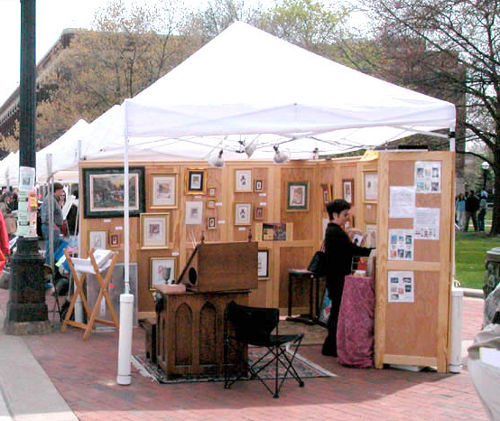 This is my booth at the
Ann Arbor Book Festival, 2005. We are right on the University of Michigan
central campus.
Here we have a whole lot f pigments, many of which are very exotic and
rare. The verdigris in the upper left corner is in a box made from a
solid chunk of oak (from the centenial oak across the street after
lightning got it). The object to its right is a pedestal type cresset
lamp (used for lighting the home, but also for collecting soot for lamp
black pigment). There's a brick from a 14th c. building which I
hollowed out to use as a fluid absorbing mass when making the yellow
lake pigment called "weld." In the center is rocella tinctoria, which
is also known as orchil. It makes the purple which was also used for
dying the purple pages of the most lavish medieval books. . We also
have Dragon's Blood, Brazilwood lake, Kermes, Orpiment & Realgar,
Lapis Lazuli from Afghanistan, Red White and Yellow Lead colors, Iris
Green, Sap Green & Buckthorn Yellow, Malachite, Azurite, and others.
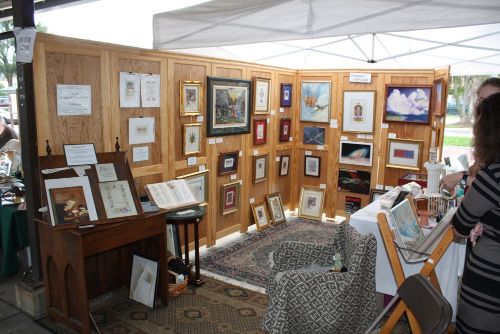 The Kerrytown Bookfest, 2011.  The Elements Gallery at the Detroit Artists' Market, 2010. Mysticon SF Convention Art Show, Roanoke, VA, 2011. 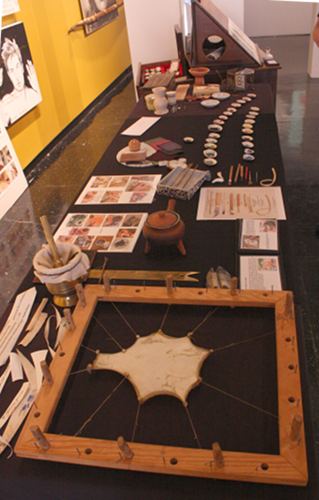 Wordage Show. Detroit MI, 2010. 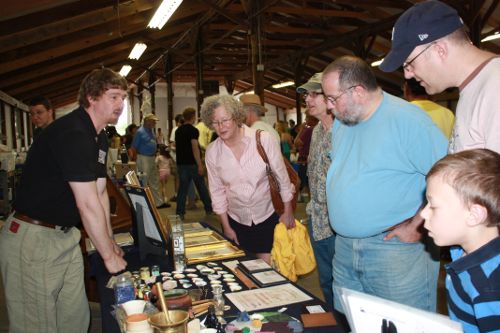 Saline, MI Maker Fair, 2010.  Ann & Randy at an SF Convention, 2011. 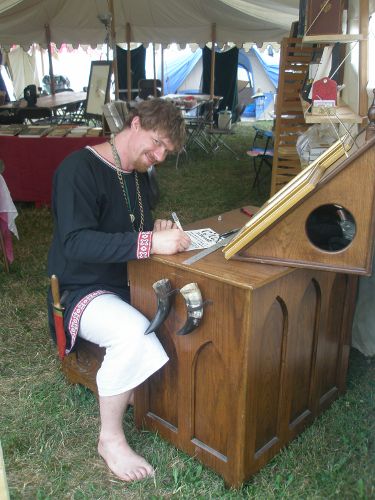 Guild Mirandola at the SCA Pennsic War |